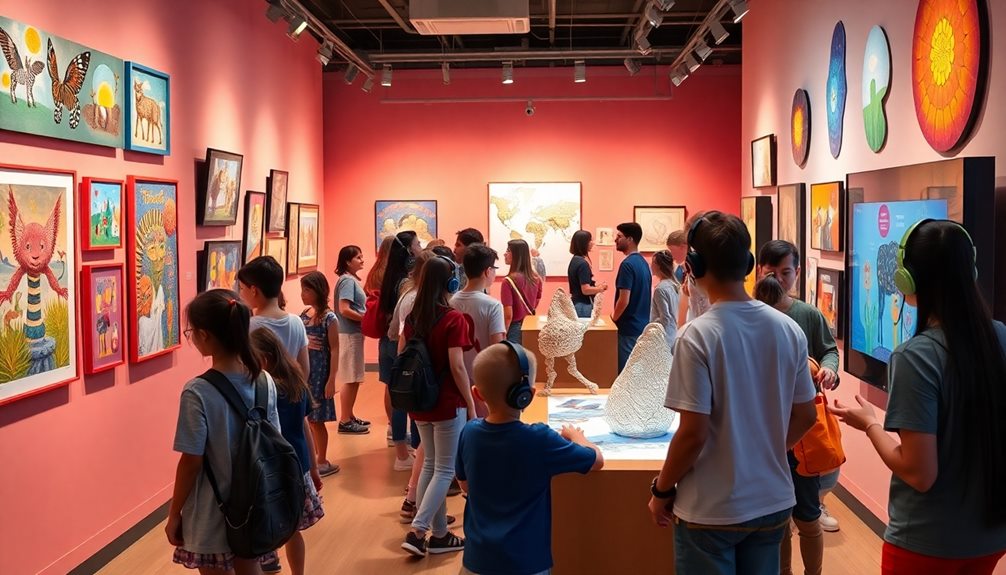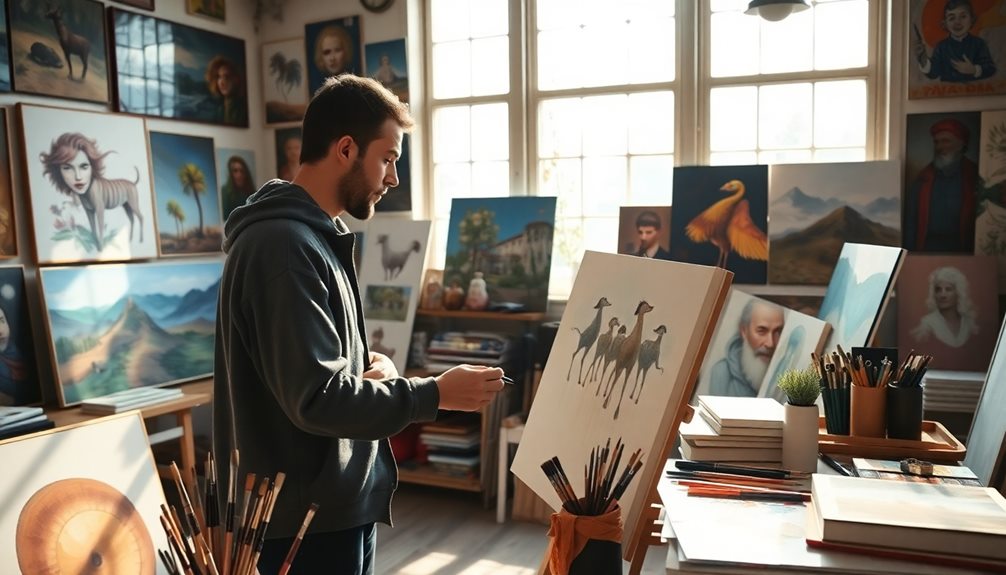Art appreciation is a personal journey shaped by your unique learning style. Whether you're a visual, auditory, kinesthetic, logical, social, or solitary learner, understanding art becomes more engaging when you tailor your approach. Visual learners thrive on images, while auditory learners benefit from discussions and artist stories. If you enjoy hands-on activities, get creative with sketching or art projects. Collaborative efforts can boost social learners, and solitary exploration suits those who prefer working independently. Recognizing and applying these styles enriches your connection to art, leading to deeper insights. Keep exploring to uncover even more methods that enhance your appreciation.
Key Takeaways
- Art appreciation is enhanced by recognizing and catering to individual learning styles: visual, auditory, kinesthetic, logical, social, and solitary.
- Engaging multiple senses through diverse teaching methods fosters deeper connections and understanding of art.
- Tailored activities, like discussions for auditory learners and hands-on projects for kinesthetic learners, boost engagement and confidence.
- Collaborative projects promote teamwork among social learners, while solitary learners benefit from independent exploration of art.
- Accessibility to resources, including virtual museum tours and online collections, enriches the art appreciation experience for all students.
Introduction
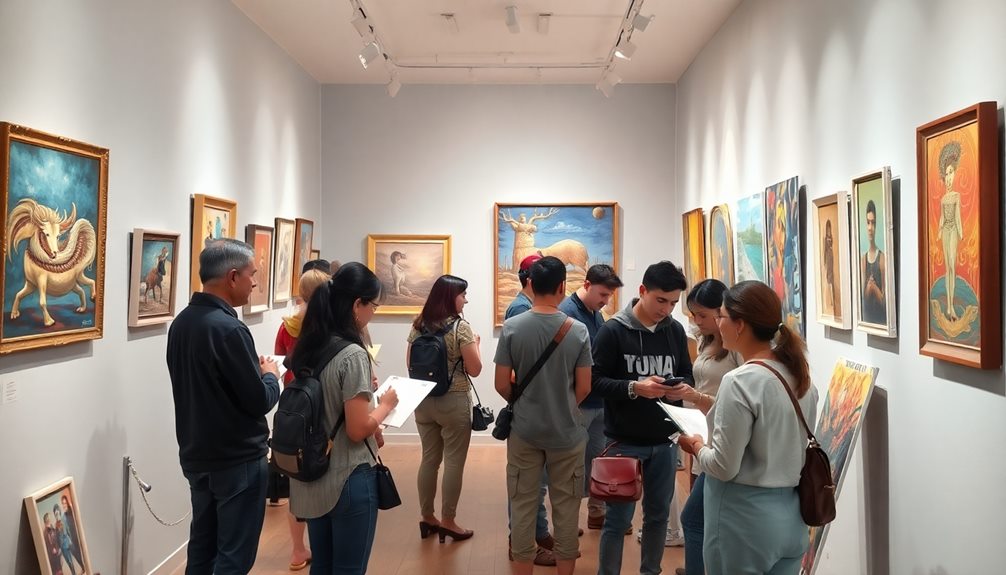
Art appreciation is more than just looking at paintings; it's a personal journey shaped by how you learn. You may not realize it, but your learning style—whether visual, auditory, kinesthetic, or verbal—plays a crucial role in how you perceive and connect with art. Art speaks to individuals in unique ways, and the psychological aspects of art appreciation influence how deeply you resonate with a piece. For instance, a visual learner might be drawn to the intricate details and color palettes, while a kinesthetic learner could be captivated by the textures and physical dimensions of the artwork. Understanding these connections can enrich your experience, making art a profound and personal exploration.
In diverse learning environments, understanding these different learning styles can significantly enhance your art appreciation experience. Engaging multiple senses can deepen your connection to artistic concepts. For instance, when you observe visually stimulating pieces, discuss their meanings, or even interact with art materials, you open up pathways for better understanding.
This hands-on approach caters to various learning preferences, encouraging broader participation. Incorporating diverse artistic styles and cultural narratives through different mediums can further enrich your appreciation of art.
Tailoring art appreciation lessons to accommodate these varied learning styles boosts not only your engagement but also your confidence and self-esteem in your artistic abilities. By embracing the unique ways you learn, you can transform your journey into a more fulfilling and enriching experience that resonates deeply with you.
Key Concepts and Definitions

Understanding key concepts and definitions in art appreciation is essential for navigating the diverse learning styles that shape your experience. Learning styles encompass seven distinct categories: visual, auditory, verbal, kinesthetic, logical, social, and solitary. Each style influences how you absorb and process information, which is crucial in art education.
For instance, visual learners thrive on images and diagrams, while auditory learners excel during discussions and lectures. Recognizing these differences highlights the need for varied teaching methods in art appreciation. Kinesthetic learners, who benefit from hands-on experiences, require interactive art activities to engage effectively.
Research shows that employing multiple senses, such as combining visual and tactile elements, enhances overall learning outcomes. This multifaceted approach not only fosters a deeper connection to the material but also improves student engagement and retention.
Tailored Activities for Each Style
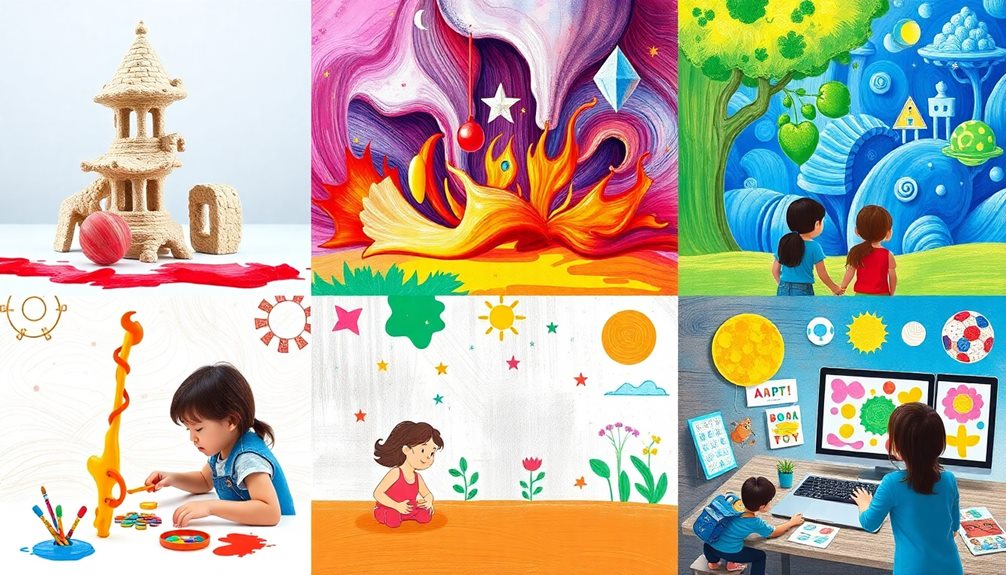
To effectively engage students in art appreciation, it's crucial to tailor activities to their unique learning styles. For visual learners, consider picture study or narration, where students observe and analyze artworks individually. This approach helps them grasp visual elements and techniques deeply.
Auditory learners benefit from discussions about the emotional impact of art, encouraging them to express their thoughts verbally and connect with the artwork on a personal level.
Kinesthetic learners thrive on hands-on experiences. Incorporate activities like sketching parts of paintings or making art inspired by studied works, allowing them to physically engage with the medium.
Logical learners can analyze patterns and themes by comparing different artists or art movements, which fosters a deeper understanding of art history and techniques.
Lastly, social learners excel in collaborative environments. Promote group projects where students create art together or discuss their interpretations, facilitating teamwork and the sharing of diverse perspectives.
Student Art Projects Showcase
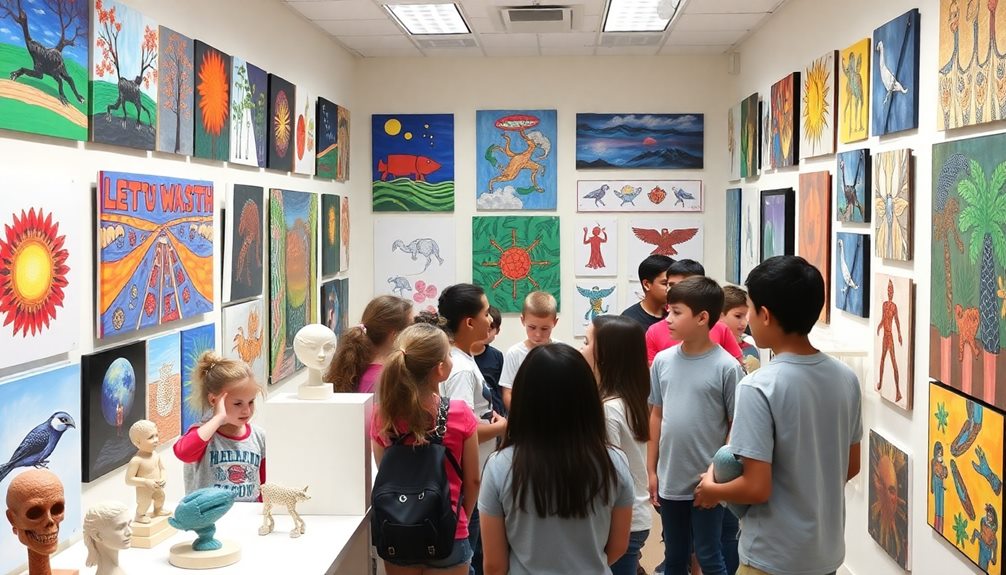
As students dive into their art projects, they not only apply the techniques and styles they've learned but also express their unique perspectives.
These student art projects serve as a culmination of their learning, allowing them to explore diverse artistic mediums, from painting to mixed media. This variety caters to different learning styles, ensuring that every student, whether they're visual, auditory, or kinesthetic learners, can engage meaningfully with art and music.
Collaboration is often a key element in these projects, promoting teamwork and communication skills vital for personal and social development. When students work together, they not only share ideas but also gain insights from one another, much like working artists do in real-world settings.
Publicly showcasing these projects in exhibitions or community displays gives students a sense of ownership over their creative expressions. This exposure boosts their confidence and encourages personal reflection, enabling them to critically think about their own cultural narratives.
Ultimately, these student art projects aren't just about skill; they're about fostering a deep connection to the art world and understanding their place within it.
Tips and Best Practices
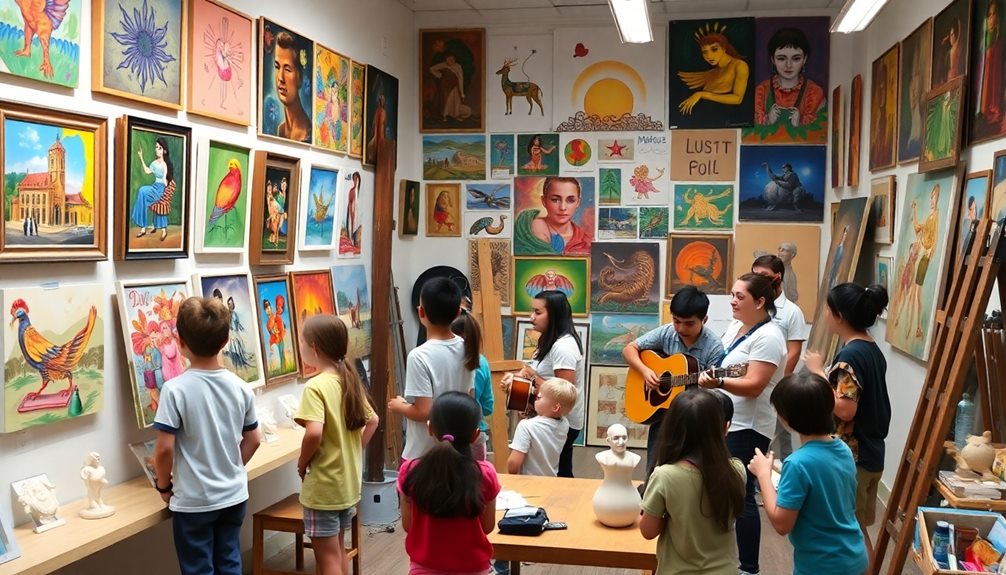
Incorporating a variety of teaching methods can significantly enhance art appreciation classes, making them more inclusive for all learning styles. As a teaching artist, you can engage students by using visual aids, hands-on activities, and auditory discussions. This approach gives students a sense of connection to the artwork and its context.
For verbal and auditory learners, utilize descriptive language and sensory vocabulary during discussions. This deepens their understanding of artistic expression.
Kinesthetic learners benefit from creating their own art or participating in movement-based activities like "Camera Yoga," allowing them to explore framing and composition in a tactile manner.
Employ picture study techniques, focusing on one artwork at a time. This encourages careful observation and discussion, catering to visual learners effectively.
Additionally, foster collaboration through group projects, enabling social learners to engage with peers. This nurtures teamwork and communication while exploring the art-making process.
Community Feedback and Insights
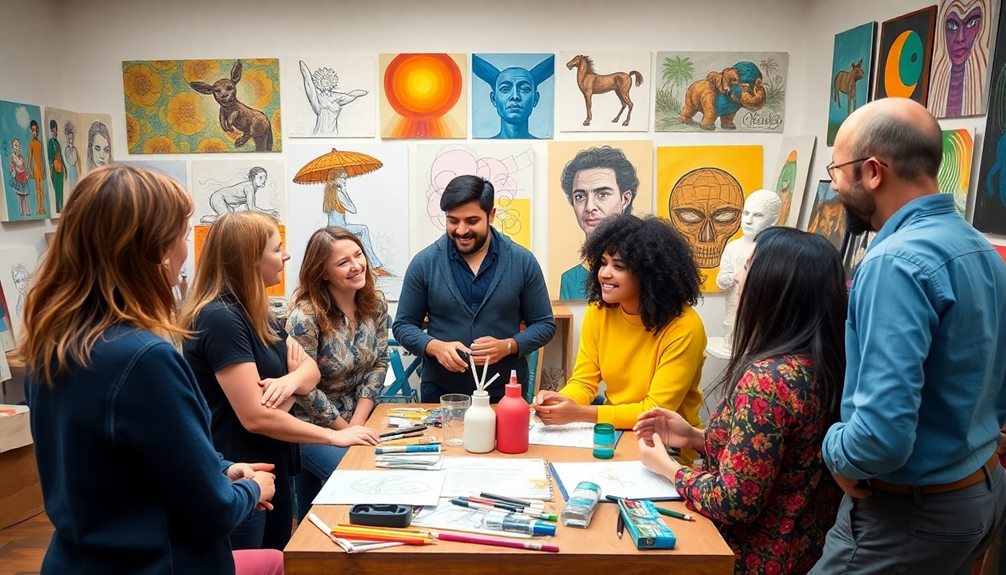
Feedback from the community underscores the positive impact of diverse teaching methods on art appreciation. Many participants note that when you incorporate hands-on activities like studio projects and field trips, students connect more deeply with art history. This engagement isn't just about understanding techniques; it's about fostering a genuine interest in the subject.
Incorporating elements from various educational tools, such as interactive experiences that engage students in creative ways, can further enhance this connection.
Surveys show that students involved in collaborative art projects report improved teamwork and communication skills, essential elements in effective learning. Community members, including local artists, emphasize how integrating real-world experiences into art education creates lasting impressions. These experiences not only enhance emotional engagement with art but also inspire students to explore their creativity further.
Moreover, community events that showcase student artwork highlight the benefits of public art projects. These initiatives foster a sense of belonging and appreciation for diverse artistic expressions, which are crucial for students from varying backgrounds.
When art becomes a shared experience, it cultivates a richer understanding of different perspectives and techniques. By prioritizing diverse teaching methods, you're not just teaching art; you're nurturing a well-rounded appreciation for the arts in all its forms.
Resource Allocation and Accessibility
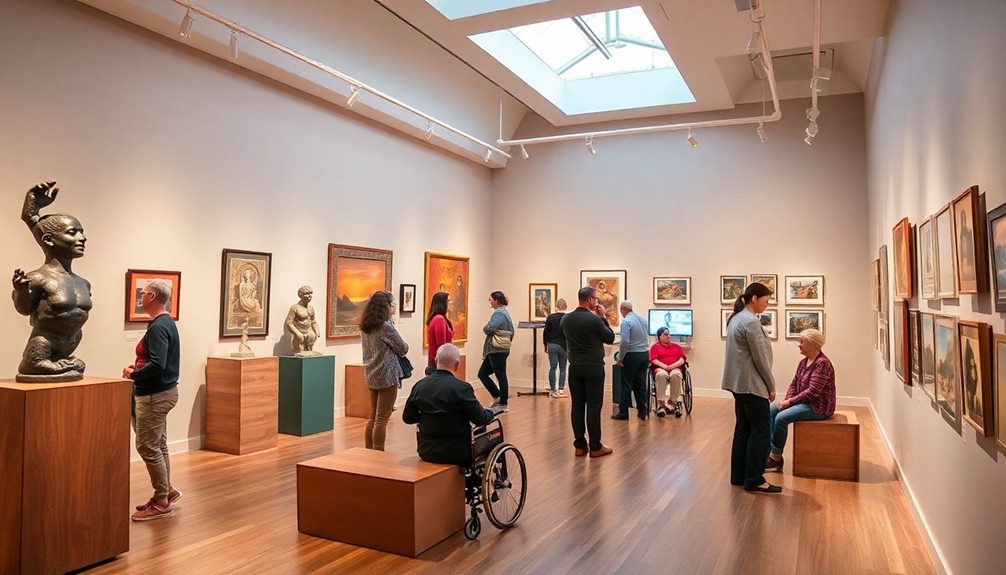
Effective resource allocation in art education is crucial for catering to diverse learning styles. When you consider the needs of visual, auditory, kinesthetic, and experiential learners, you can create a rich learning environment that maximizes engagement and comprehension.
By ensuring accessibility to various art resources, like online collections and virtual museum tours, you allow students to explore visual art in ways that suit their preferences.
For instance, providing hands-on art supplies and interactive tools supports kinesthetic learners who thrive on doing. Meanwhile, using visual aids and descriptive language helps visual and auditory learners grasp artistic concepts more effectively.
Collaboration with community organizations can also enhance accessibility, bridging gaps in resource availability and promoting inclusivity in art appreciation.
Incorporating technology, such as educational platforms and online galleries, further enhances resource allocation. It offers flexible, diverse ways for you to engage with art regardless of your preferred learning style.
Additional Resources
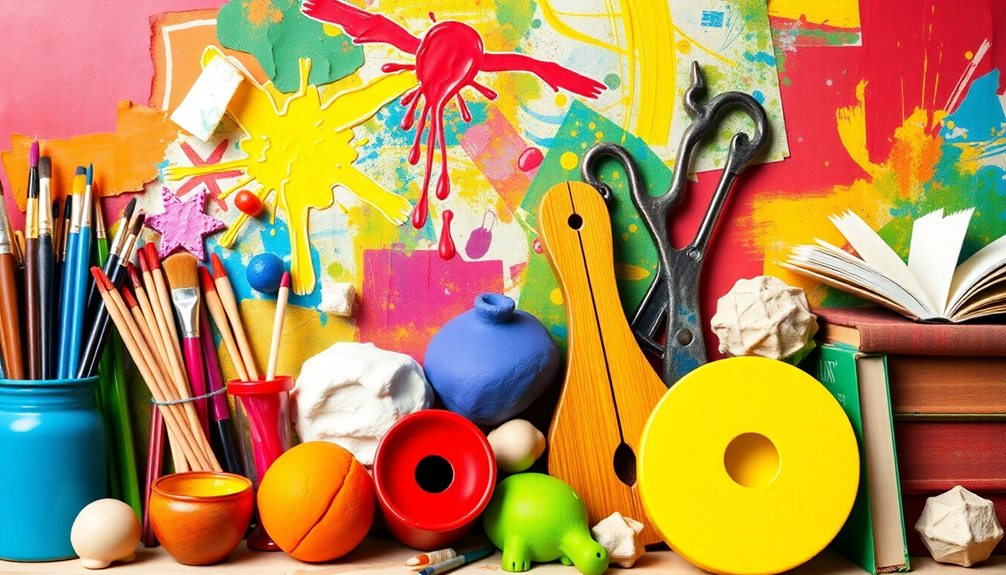
Art appreciation doesn't have to be confined to traditional classrooms. You can explore a wealth of additional resources tailored to different learning styles. For example, online platforms like ABCGallery.com offer extensive collections of artworks, perfect for visual learners who thrive on observation.
If you're an auditory learner, consider virtual art museum field trips. These immersive experiences feature guided tours and expert commentary that deepen your understanding.
Kinesthetic learners can engage with interactive resources, such as coloring pages and sketching exercises. By hands-on activities, you'll connect more directly with art concepts.
If you prefer a verbal approach, you might enjoy utilizing artist biographies and historical context to enrich your storytelling and reading experiences.
Moreover, if you're a logical learner, incorporating multimedia presentations and videos can effectively illustrate art techniques and historical connections. These organized resources help you grasp complex ideas clearly.
Whether you're interested in music appreciation or taking art classes, these additional resources can enhance your learning journey. With the right tools, you'll find art appreciation accessible and enjoyable, regardless of your preferred learning style.
Frequently Asked Questions
What Are the Learning Styles in Art?
In art, you'll encounter various learning styles: visual learners thrive on images, auditory learners engage through discussions, kinesthetic learners prefer hands-on activities, logical learners analyze concepts, while social and solitary learners gain from collaborative or independent work.
What Is the Learning of Art Appreciation?
The learning of art appreciation involves exploring various artworks, understanding their meanings, and connecting emotionally. You'll develop critical thinking skills, gain cultural insights, and foster empathy, enriching your personal experiences and enhancing your understanding of diverse perspectives.
What Thinking and Learning Style Is Required for Artistic People?
Artistic people often thrive with a mix of kinesthetic, visual, and auditory learning styles. You'll find that hands-on experiences, engaging visuals, and inspiring sounds enhance your creativity and deepen your connection to art.
How Has Art Played an Important Role in Your Learning Process?
Art's played a vital role in your learning process by sparking creativity and enhancing critical thinking. You've connected emotionally with pieces, allowing deeper understanding and retention while broadening your perspective on diverse cultures and ideas.
Conclusion
Incorporating art appreciation into your teaching can engage every learner, regardless of their style. By tailoring activities to visual, auditory, and kinesthetic preferences, you'll foster a deeper connection to art. Don't forget to showcase student projects and gather feedback to refine your approach. With thoughtful resource allocation, you can make art accessible to all. Keep exploring new ways to inspire creativity, and remember, art appreciation is a journey that benefits both you and your students!
